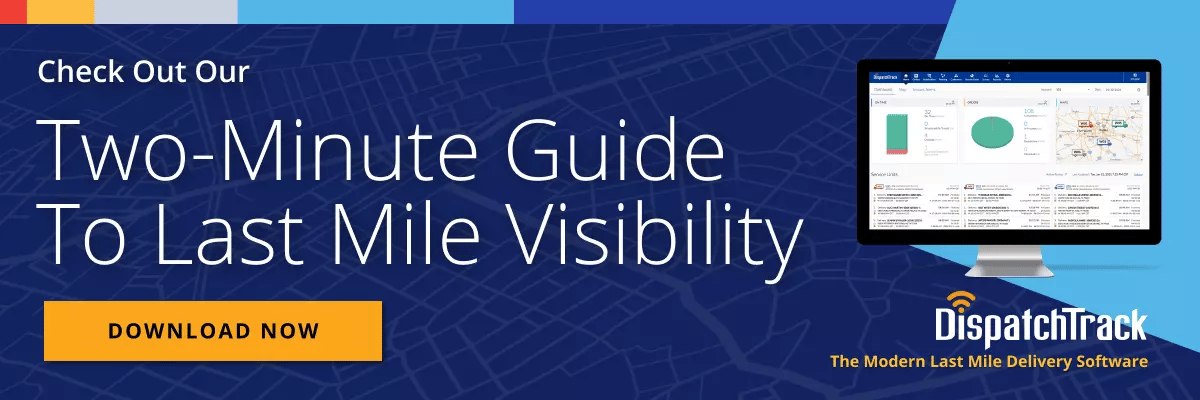If you looked at the headline and immediately answered: fuel prices—you’re only half right. According to Dispatchtrack’s 2022 Holiday Perspective, 93% of businesses expect operating costs to rise when you account for fuel prices. The portion of respondents who expected a rise in operating costs before accounting for fuel? An almost identical 92%.

In other words, volatile fuel costs aren’t the only thing making deliveries more expensive as we head into 2022’s peak season. Of course, they’re going to play a role—but our data uncovered concerns that included driver shortages, inflation, inventory shortages, and numerous other factors that can drive up operating costs and make cost-efficient deliveries more difficult to achieve.
In this post, we’ll dig a little deeper into why businesses are expecting these large jumps in operating cost, and what they can do to keep costs manageable and handle peak season deliveries without breaking the bank.
What’s Driving Up Costs of Delivery Organizations?
When we surveyed logistics professionals on their expectations for the coming holiday season, increasing costs represented one of the few areas of relatively unanimous agreement. On balance, however, predicting outcomes for peak season deliveries was tricky, Roughly equal numbers of respondents expected business to grow as expected business to shrink, and while driver and inventory shortages were certainly shared concerns, they weren’t overwhelmingly concerning the way that fuel prices (which 80% of respondents expressed concern about) were.
A few of the other top concerns were:
- inflation (50%)
- driver shortages (48%)
- losing business due to the economy (38%)
- delays out of their control (37%)
- keeping up with demand (23%)
Not all of these necessarily translate directly into cost increases—but they all contribute to an atmosphere of uncertainty. When you don’t know what to expect, planning and forecasting obviously become more difficult. When planning is more difficult, you wind up with less effective plans, e.g. plans that are either too ambitious to actually execute or plans that don’t ultimately rise to meet demand.
In other words, this kind of uncertainty around costs and demand can lead to a vicious cycle that causes further disruptions and uncertainty over time. When you can’t be sure you’ll have the resources necessary to meet demand, you can’t be sure of delighting your customers and maintaining their business—just as you can’t be sure of carrying out deliveries in a way that’s actually cost-efficient. To wit, including fuel, more than two-thirds of last mile delivery companies expected operating costs to increase by either 10-20% or 25-50%.

What Do Increased Costs Mean for Peak Season Deliveries?
Right now, the most immediate impact of the cost pressures around delivery for this upcoming holiday season is that delivery prices are going to increase. About 75% of businesses said that they intended to raise prices, due to a combination of fuel cost increases, inflation, and other factors.
But the impact to customers doesn’t necessarily end there. In fact, when asked about concerns beyond cost factors, 82% of businesses said they were concerned about missing delivery windows this upcoming holiday season—with two-thirds of respondents more concerned about that than they were a year ago. Again, driver and inventory shortages play a role here. When you can’t be sure that you’ll have the goods—or the resources—you need to fulfill customer orders, you’re potentially looking at negative business impacts if you can’t find a way to mitigate the situation.
Simply put, the feeling among logistics professionals right now is that this year’s holiday delivery season is likely to look a lot like last year’s, but more so. Increased costs mean that delivery organizations will be trying to do more with less, and potentially volatile demand might result in capacity crunches and consumer frustration.
How to Fight Increasing Costs with Right-Time Delivery Management
Businesses are taking different approaches to preparing for these scenarios. Only about a third of respondents said that they were planning for the holiday earlier this year than last year, but most businesses are taking at least some concrete steps to make themselves more resilient to the uncertainty and potential disruptions that are headed their way:
- 40% of businesses are renting extra warehouse space or trucks or both in order to stay ahead of potential fulfillment hurdles.
- 50% have invested in new technology or expanded their use of existing technology this year.
Of course, there are numerous different approaches that businesses might take to managing peak season volume increases—and there’s no obvious consensus among the businesses we polled as to what the best approach is. But at a very high level, the right solutions are going to be those that can help you reduce costs while building resiliency and flexibility into your delivery operations.
Adding extra assets or warehouse space can help you accomplish the second part—but to hit both cost-savings and increased flexibility, technology is going to have to play a large role. Specially, you’re going to need technology that can power right-time deliveries in periods of high cost, volatile demand, and high uncertainty.
What do we mean by right-time delivery?
Simply put, right-time delivery encompasses all of the processes and tools that go into enabling delivery organizations to deliver at the right time for their customers. This involves:
- Efficient routing that can enable you to maximize capacity
- AI to ensure that your delivery ETAs are hyper-accurate
- Constant customer communication to ensure that the delivery time actually works for the customer
- Real-time visibility that enables you to manage disruptions and delays before they become an issue.
When you can put all of these elements together, you take control over your last mile deliveries. The result is that you can boost customer satisfaction while keeping costs under control.
How does right-time delivery management impact costs?
When you drive fewer miles, you spend less money on both fuel and labor. When you can streamline and automate processes that used to be manual or otherwise inefficient, you can save on back-office costs. A right-time delivery approach enables you to do both. By predicting delivery times accurately, you can get more revenue out of your existing capacity and avoid redelivery attempts by drastically reducing the number of missed and failed deliveries.
The result is that you don’t waste fuel and labor on unnecessary redelivery attempts. At the same time, the same AI-powered technology that makes it possible to ensure that your route plans can actually be executed also helps streamline back-office processes to save your teams time and money. The result is that even when things are uncertain, you can reduce delivery costs across the board—so that when fuel prices spike or the driver shortage gets more acute, you can weather the storm more easily.
How does right-time delivery make you more flexible?
The other side of the coin when it comes to right-time delivery management is ensuring flexibility and agility in delivery planning. The idea of a right-time delivery might seem rigid or overly fixed from the outside, but in point of fact it’s quite the opposite: “right-time” means finding the right time for your plans, your business, and your customers. Ultimately when you have smart technology that’s capable of efficiently streamlining processes, you can set yourself to respond to last-minute orders, staff shortages, and other disruptions without having your delivery plans fall apart.
As we approach a holiday season that looks like it will be particularly challenging from the perspectives of cost and volatility, it’s hard to overstate the value of an approach that prioritizes fast, flexible, and adaptable last mile delivery planning and execution.
Read DispatchTrack’s 2022 Holiday Perspective to learn more!